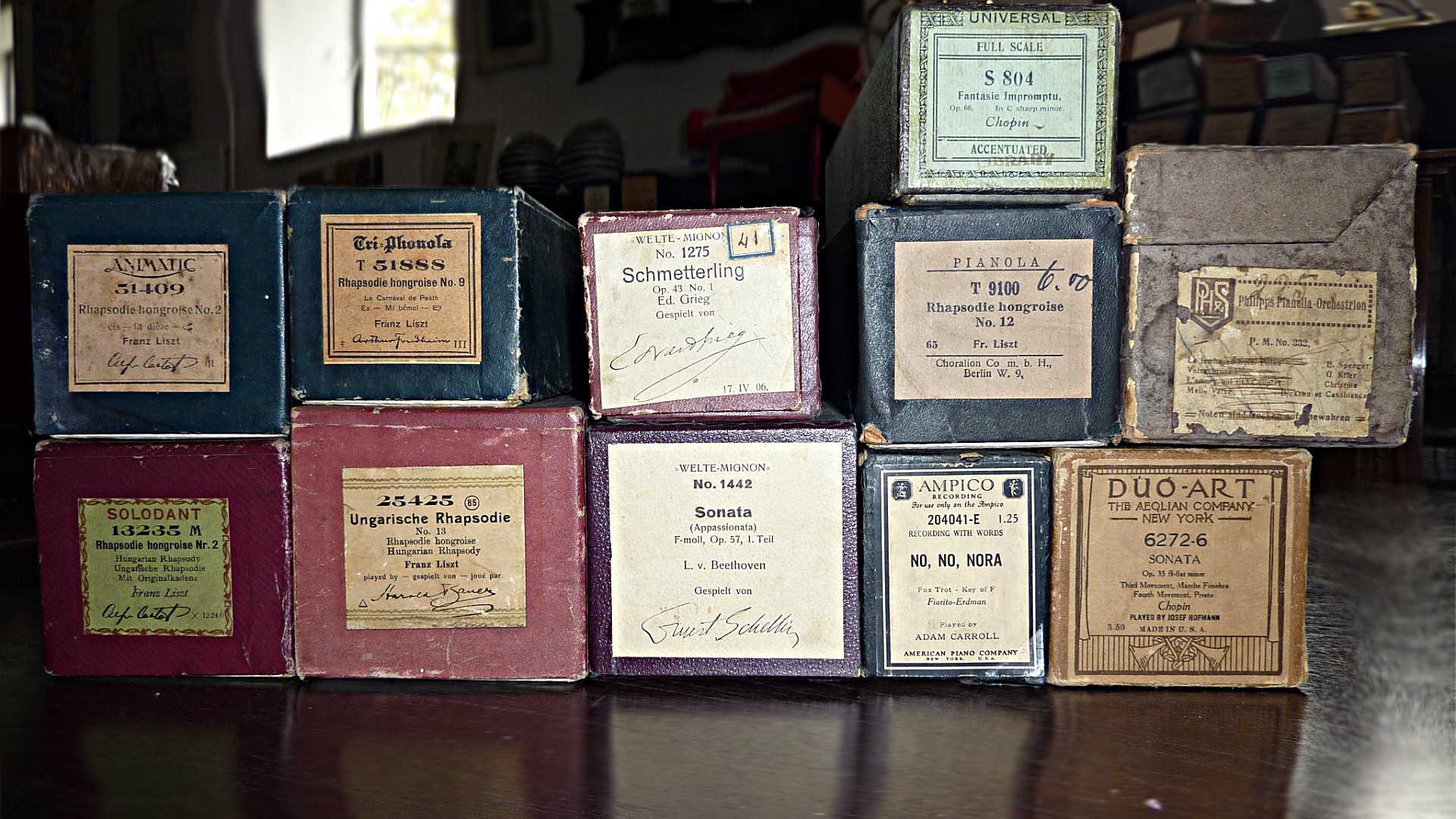As with pianolas, the rolls of music differ considerably according to manufacturer, age and type. There are many different types of scrolls and they only fit certain types of pianolas. The value of the rolls still preserved today also differs greatly, depending on the number of rolls still preserved today and the number of potential buyers.
The following characteristics can be used to distinguish the many types of music rolls:
Type of roles (drawn roles, artist roles)
Scale (standard: 65 and 88 and manufacturer-specific: 72, T98, T100, etc.)
Title (beauty, quality and rarity of the music pieces)
TYPES OF ROLLS
The role type describes the way in which the note roll is created. Although the manufacturers used all sorts of terms for advertising purposes in the sense of a unique position, two main types of rolls can be distinguished: the drawn, unrecorded rolls and the recorded artist rolls.
DRAWN ROLLS
Drawn scrolls were directly converted 1:1 from the sheet of music by so-called note drawers to scrolls. Arranged scrolls contain additional editorial intervention in order to adapt the piece of music more to contemporary taste. These drawn rolls (also called ordinary rolls) should give the pianist the greatest possible freedom in the interpretation of the piece of music. There are already different roles of the same piece of music, because the notation was dependent on the edition of the respective piece of music. Drawn rolls are available for 65, 72 and 88 systems in very large numbers. Especially in the USA this type of role has become very popular.
ARTIST'S ROLLS
Recorded scores were created by recording the original playing of a pianist on special recording grand pianos - and usually also editing them. These rolls were usually signed by the pianist to document that the roll represents the pianist's playing. At Hupfeld and other manufacturers these rolls were called artist's rolls. Welte only issued recorded rolls. At Aeolian, these rolls carried the inscription "hand played".
Artist reels were produced by the manufacturers in two variants. As artist rolls for art pianos, i.e. the music rolls contained the recorded hand play of the pianist, the melody accentuation and the fortepedal. The further dynamics are the responsibility of the pianist. This type of role was produced in large numbers - for example the Phonola and Animatic roles by Hupfeld, the Ducanola/PhilAG roles by Philipps. The second type are the much rarer reproduction reels - here all information is included that is necessary for fully automatic playing including all details. This type of roles includes Welte-Mignon roles, DAE roles, Tri-Phonola roles, DUCA roles, Duo-Art and Ampico roles.
No matter how the recording was realized - assuming good quality - the decisive moment for a role of very good quality was the process of post-production, also with the collaboration of the pianist/composer. Even if this post-processing did not aim at any changes to the recording, but only at technical corrections. Thus, the reworking of some parts produced a really very good result.
As with today's artist recordings, however, there was often the striving to optimize the recording by perfecting individual passages, raising the tempo, etc. From an interpretation point of view, intensive research and discussions are still being conducted today to clarify the authenticity of the role recordings. Audio recordings from the same period clearly show that the original playing was indeed captured very well, although even with the first audio recordings the artists adapt their playing strongly to the recording technique. Regardless of all these technical details, subjective perception remains the decisive factor in music enjoyment.
SKALA
The scale indicates the structure (number, width and position) of the perforations on the paper, i.e. the number of notes, the possible control information for melody emphasis and pedal and any additional control information for reproduction functions. As a result, the roll paper widths used by the different manufacturers also vary considerably. In addition, the roll flanks and the pins or recesses for roll reception on the sides are different. Only the 65 and 88 standard rolls can be played on all standard 65 and 88 pianolas. All other reels are only suitable for certain manufacturers, e.g. the 72 Phonola reel is only suitable for Hupfeld Phonola. The scales of the reproduction pianos were all manufacturer-specific, i.e. no roll is compatible with any other system. The different scale formats are described in individual sections.
ROLLING TITLE
The market leaders soon had the most important pianists and composers under contract - not necessarily contractually exclusive, but de facto exclusive in cases where these artists did not make recordings in other places. Some pianists have recorded on almost all systems, e.g. Oswin Keller. However, given the huge repertoire, numerous titles had to be recorded for which no renowned pianist was available. Thus Hupfeld, Phillips and all the others had quasi house pianists who were often not even listed by name - the main thing was that the roles could be played as artist roles. Just like today, the manufacturers published the most modern music, the latest hits, the hottest artists. The big manufacturers also tried to systematically offer roles for specific target groups, e.g. regional titles, accompanying music, dance music, marches, etc. With subscriptions, the producers tried to retain customers. In the peak phase, hundreds of thousands of titles were released - an oversupply, which understandably led to price wars. Due to the short peak phase of the Pianola, the available titles were less decisive in the end - economically most successful were those that conquered the market first, i.e. mainly Welte.


